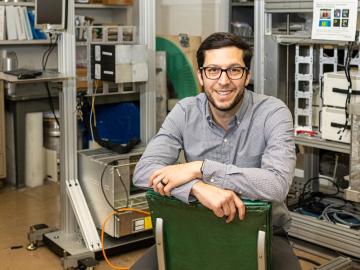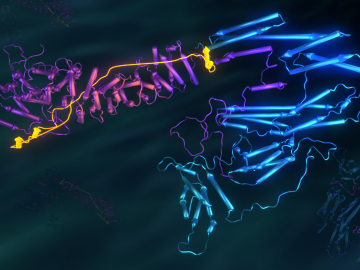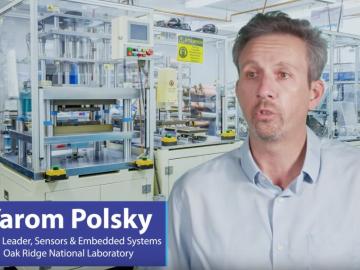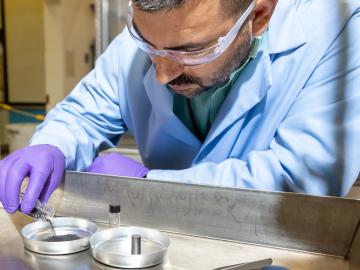
Filter News
Area of Research
- Advanced Manufacturing (5)
- Biological Systems (1)
- Biology and Environment (32)
- Computational Biology (2)
- Computational Engineering (2)
- Energy Science (34)
- Fuel Cycle Science and Technology (1)
- Fusion and Fission (29)
- Fusion Energy (10)
- Isotope Development and Production (1)
- Isotopes (12)
- Materials (58)
- Materials for Computing (8)
- Mathematics (1)
- National Security (10)
- Neutron Science (121)
- Nuclear Science and Technology (40)
- Nuclear Systems Modeling, Simulation and Validation (1)
- Supercomputing (33)
News Type
News Topics
- (-) Biomedical (72)
- (-) Clean Water (33)
- (-) Molten Salt (10)
- (-) Neutron Science (166)
- (-) Nuclear Energy (118)
- (-) Space Exploration (26)
- 3-D Printing/Advanced Manufacturing (141)
- Advanced Reactors (38)
- Artificial Intelligence (129)
- Big Data (75)
- Bioenergy (111)
- Biology (128)
- Biotechnology (39)
- Buildings (70)
- Chemical Sciences (85)
- Composites (34)
- Computer Science (222)
- Coronavirus (48)
- Critical Materials (29)
- Cybersecurity (34)
- Education (5)
- Element Discovery (1)
- Emergency (4)
- Energy Storage (112)
- Environment (210)
- Exascale Computing (65)
- Fossil Energy (8)
- Frontier (62)
- Fusion (65)
- Grid (72)
- High-Performance Computing (126)
- Hydropower (12)
- Irradiation (2)
- Isotopes (60)
- ITER (9)
- Machine Learning (67)
- Materials (149)
- Materials Science (154)
- Mathematics (12)
- Mercury (12)
- Microelectronics (4)
- Microscopy (55)
- Nanotechnology (62)
- National Security (84)
- Partnerships (68)
- Physics (69)
- Polymers (34)
- Quantum Computing (52)
- Quantum Science (91)
- Security (31)
- Simulation (63)
- Software (1)
- Statistics (4)
- Summit (70)
- Transportation (97)
Media Contacts

If humankind reaches Mars this century, an Oak Ridge National Laboratory-developed experiment testing advanced materials for spacecraft may play a key role.

Jason Nattress, an Alvin M. Weinberg Fellow at the Department of Energy’s Oak Ridge National Laboratory, found his calling on a nuclear submarine.

The U.S. Department of Energy announced funding for 12 projects with private industry to enable collaboration with DOE national laboratories on overcoming challenges in fusion energy development.

Two of the researchers who share the Nobel Prize in Chemistry announced Wednesday—John B. Goodenough of the University of Texas at Austin and M. Stanley Whittingham of Binghamton University in New York—have research ties to ORNL.

The type of vehicle that will carry people to the Red Planet is shaping up to be “like a two-story house you’re trying to land on another planet.

Researchers used neutron scattering at Oak Ridge National Laboratory’s Spallation Neutron Source and High Flux Isotope Reactor to better understand how certain cells in human tissue bond together.

Using the Titan supercomputer and the Spallation Neutron Source at the Department of Energy’s Oak Ridge National Laboratory, scientists have created the most accurate 3D model yet of an intrinsically disordered protein, revealing the ensemble of its atomic-level structures.

The National Alliance for Water Innovation, a partnership of the Department of Energy’s Oak Ridge National Laboratory, other national labs, university and private sector partners, has been awarded a five-year, $100 million Energy-Water Desalination Hub by DOE to address water security issues in the United States.

Researchers used neutron scattering at Oak Ridge National Laboratory’s Spallation Neutron Source to probe the structure of a colorful new material that may pave the way for improved sensors and vivid displays.

Ask Tyler Gerczak to find a negative in working at the Department of Energy’s Oak Ridge National Laboratory, and his only complaint is the summer weather. It is not as forgiving as the summers in Pulaski, Wisconsin, his hometown.


